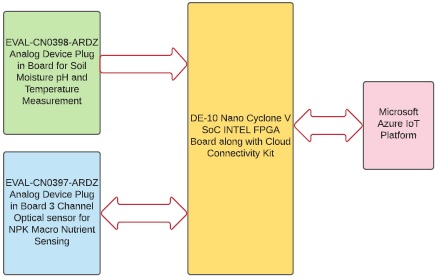
Nowadays the major problems in Indian agriculture are small holdings, depleted soil and lack of easily driven systems to improve the yield at a large scale. In order to provide remedy for this issue,there is a need of a system which is easily accessible to monitor their plant health by providing data for their field conditions, humidity, pH level, water salinity and provide use full data about their plant. With the advent of recent developments in sensor technology and Embedded systems, its is possible to monitor the soil parameters and plant health. This research aims at providing assistance to the farmers for smart farming by developing smart IoT based real time systems for soil sensing and plant health monitoring. This proposed system measures the level of macro-nutrients present in the soil by using real time on the go technique. Further measured parameters are communicated to farmers in order to take decisions on water management, fertilizer utilization, crop selection and cultivation. In order to monitor the plant health ,the proposed system incorporates real time image acquisition and image processing techniques to detect the abnormalities on the surface of the leaves.
Demo Video
Project Proposal
1. High-level project introduction and performance expectation
This research project develops a system that senses the real time soil health (measures the macro-nutrients in the soil) using embedded system and IoT. The macro-nutrients Nitrogen (N),Phosphorous (P) and Potassium (K) commonly known as the NPK trio are the most important nutrients for plant growth and are also the main ingredients in any fertilizer. To increase crop yield fertilizers containing predominantly nitrate (N), phosphate (P), and potassium (K) are essential. Improper use of fertilizers in turn results into poor quality in fruits, vegetable lagging in color, size, test and even quantity. In China over-application of fertilizers has caused low fertilizer usage efficiency (~35% in average) resulting in low agricultural product quality, serious environmental pollution, etc. Quantity of NPK is dependent on crop type and on plant growth status. How much quantity of fertilizer to be used is further dependent on present contents of NPK nutrients in the soil. Researchers in agriculture are looking for ways to optimize plant yield while minimizing the consumption of fertilizer. Since these macro-nutrients vary even on a small scale throughout a cultivated field, numerous researchers have attempted to develop the sensors to map these nutrient contents. Integrated crop management systems have been designed to study spatial and temporal behavior of NPK . Continuous monitoring of these along with humidity and pH of soil is leading to an automation in agricultural areas to improve crop productivity. The present study deals with the actual detection of NPK values of the soil using multimode plastic fiber optic sensor. Aqueous solution of soil under test is illuminated by different light colors. Light gets reflected from solution depending upon its absorbent coefficient of soil. Reflected light is received by another optic fiber which is converted into electrical signal. Further using threshold values stored in database of microcontroller one can determine NPK levels. This helps in detecting the deficient component of the soil. Thus undesired dispensing of the fertilizers can be controlled which in turn reduces deterioration of soil.A lot of attention has been focused in this area in the recent years, particularly in the area of precision agriculture and site specific management procedures for obtaining localized on the go measurement of NPK in any soil.
2. Block Diagram
3. Expected sustainability results, projected resource savings
The conventional testing of soil in laboratories takes upto a week which is both not so cost efficient as well as time consuming. The primary aim is to design a low cost, reliable single integrated device which maps the deficient component of the soil in no time. Thus undesired dispensing of the fertilizers can be controlled which in turn reduces deterioration of soil. By using this cost effective and hand held device, deterioration of the soil in the long term basis can be avoided. Also the user will be aware of the required quantity of fertilizer to be applied. So the cost of usage of fertilizers can be scaled down and irrigation can be done accordingly. The user can get high yield without reducing the fertility of the soil. The NPK sensor uses light spectrum to measure NPK levels. So it doesn't produce any hazardous wastes and also eco friendly as well as reliable.
4. Design Introduction
As the rapid population growth demands increase in food production, Improper use of fertilizers in turn results into poor quality in fruits, vegetable lagging in color, size, taste and even quantity. The macro-nutrients such as Nitrogen (N),Phosphorous (P) and Potassium (K) commonly known as the NPK trio are the most important nutrients for plant growth and are also the main ingredients in any fertilizer. Quantity of NPK is dependent on crop type and on plant growth status. How much quantity of fertilizer to be used is dependent on present contents of nutrients in the soil. The conventional soil tests conducted in labs is often time consuming and also not cost effective. Our aim is to design a low cost single integrated device which maps the deficient component of the soil in no time. Thus undesired dispensing of the fertilizers can be controlled which in turn reduces deterioration of soil. In this system, an NPK sensor device is used for continuous nutrient determination and pH, Soil moisture, Temperature and Humidity which are also some essential parameters for fertilizing. The primary aim of this system is to develop a sensitive and reliable agricultural device using sensors for monitoring the nutrients in soil sample for long-term applications. We chose FPGA as it is easy to program manually any number of times and preferred for application specific prototypes and offeres a higher computational power.
5. Functional description and implementation
Continuous monitoring of NPK levels along with moisture, Temperature, humidity and pH of soil is leading to automation in agricultural areas to improve crop productivity. From the fact that aqueous solution of soil under test is illuminated by different light colors. Light gets reflected from solution depending upon its absorbent coefficient of soil. Reflected light is received by another optic fiber which is converted into electrical signal. Further using threshold values stored in database of microcontroller, NPK levels can be determined. This helps in detecting the deficient component of the soil. Thus undesired dispensing of the fertilizers can be controlled which in turn reduces deterioration of soil. This system consists of pH Sensors, moisture sensors, temperature sensors, NPK sensors and DE 10 nano. Here the pH sensors measure hydrogen-ion activity (acidity or alkalinity) in soil by measuring the voltage or potential difference of the soil. The DE 10 nano gets the input from the from the pH Level Sensors, Temperature sensors, Moisture sensors and NPK Sensors. It sends the data to both display device and Wi-Fi module. The data processed in the microcontroller is sent to the Cloud through WIFI Modem using internet connection. The data are stored in the IOT cloud. The data are compared with the existing predefined data in the database. This database is collected from conducting various soils testing on various soil using chemicals in the local laboratories. After comparing the data processed with the predefined values, the website displays the suggested crops which can be cultivated in the soil and accurate amount of fertilizers that can be used in that soil.
6. Performance metrics, performance to expectation
7. Sustainability results, resource savings achieved
8. Conclusion

0 Comments
Please login to post a comment.